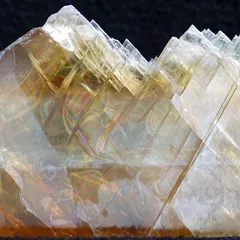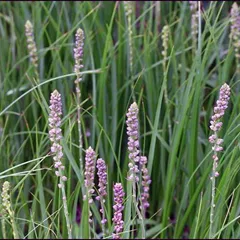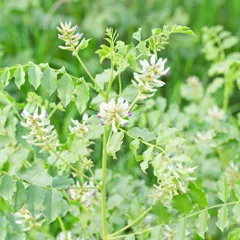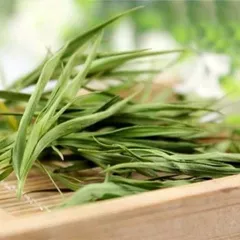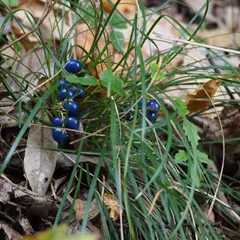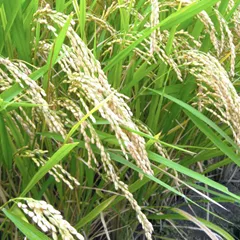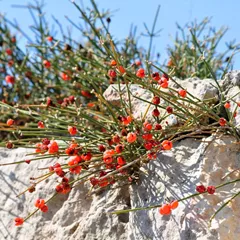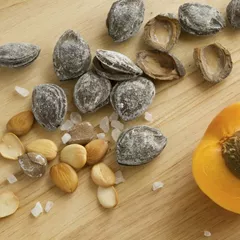Hua Ban Tang
Hua Ban Tang
Chinese: 化斑汤
Pinyin: Huà Bān Tāng
Other names: Transform Maculae Decoction
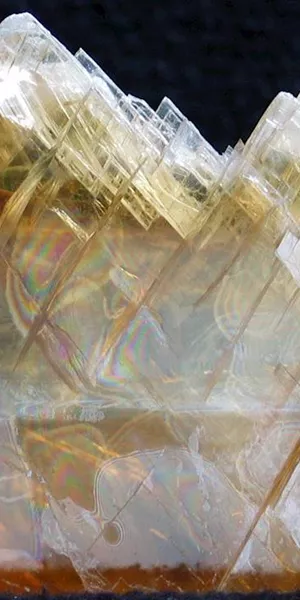
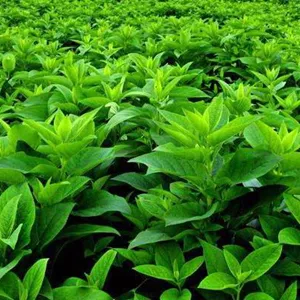
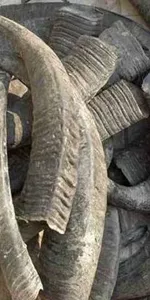
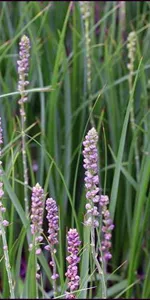
Hua Ban Tang
Hua Ban Tang
Chinese: 化斑汤
Pinyin: Huà Bān Tāng
Other names: Transform Maculae Decoction
Number of ingredients: 6 herbs
Formula category: Formulas that clear Heat from Qi and Blood
Conditions for which it may be prescribed: Macular rash
- Clears Qi-level Heat
- Cools the Blood
Contraindications: Contraindicated in cases with Yang Deficiency or weak Spleen and Stomach.
Source date: 1798 AD
Source book: Systematic Differentiation of Warm Pathogen Diseases
The information provided here is not a replacement for a doctor. You shouldn't use it for the purpose of self-diagnosing or self-medicating but rather so you can have a more informed discussion with a professional TCM practitioner.
Hua Ban Tang is a 6-ingredient Chinese Medicine formula with Gypsum (Shi Gao) as a principal ingredient.
Invented in 1798 AD, it belongs to the category of formulas that clear Heat from Qi and Blood. Its main actions are: 1) clears Qi-level Heat and 2) cools the Blood.
In Chinese Medicine health conditions are thought to arise due to "disharmonies" in the body as a system. These disharmonies are called "patterns" and the very purpose of herbal formulas is to fight them in order to restore the body's harmony.
In this case Hua Ban Tang is used by TCM practitioners to fight patterns like Stomach Heat or Fire or Heat in the Blood. From a Western Medicine standpoint, such patterns can give rise to a range of conditions such as macular rash for instance.
On this page, after a detailed description of each of the six ingredients in Hua Ban Tang, we review the patterns and conditions that Hua Ban Tang helps treat.
The six ingredients in Hua Ban Tang
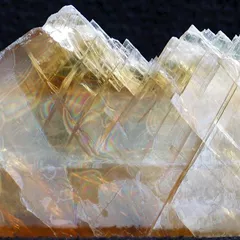
Shi Gao is a king ingredient in Hua Ban Tang. Like the name indicates, it means it has more power than other ingredients in the formula.
1. Gypsum (Shi Gao)
Part used: The mineral itself
Nature: Cold
Meridian affinity: LungStomach
Category: Herbs that clear Heat and purge Fire and/or clear Summer Heat
In general Shi Gao's main actions are as follows: "Clears Heat and drains Fire. Clears Lung Heat. Relieves thirst and restlessness. Clears Stomach Heat."
In the context of Hua Ban Tang, it is used because it clears the intense Heat in the Qi Level that is the root cause of the disease.
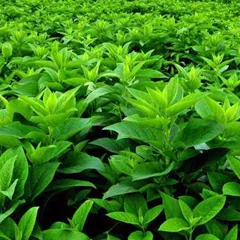
Xuan Shen is a deputy ingredient in Hua Ban Tang. This means it helps the king ingredient(s) treat the main pattern or it serves to treat a coexisting pattern.
2. Ningpo Figwort Roots (Xuan Shen)
Part used: Dried rhizome
Nature: Cold
Taste(s): Bitter
Meridian affinity: Large intestineLiverStomach
Category: Herbs that cool the Blood
Xuan Shen resolves Toxic-Heat in the Blood Level and nourish the Yin Fluids, thereby helping to push the pathogen back to the Qi level.
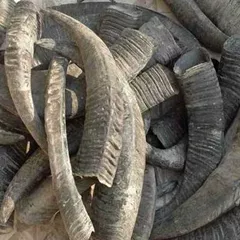
Shui Niu Jiao is a deputy ingredient in Hua Ban Tang. This means it helps the king ingredient(s) treat the main pattern or it serves to treat a coexisting pattern.
3. Water Buffalo Horns (Shui Niu Jiao)
Part used: The horn, as a powder or as thin scrapes
Nature: Cold
Meridian affinity: StomachHeartLiver
Category: Herbs that cool the Blood
Shui Niu Jiao resolves Toxic-Heat in the Blood Level and nourish the Yin Fluids, thereby helping to push the pathogen back to the Qi level.
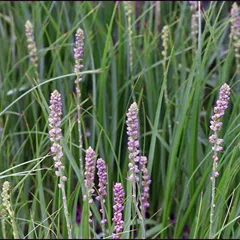
Zhi Mu is an assistant ingredient in Hua Ban Tang. This means that it either serves to reinforces the effect of other ingredients or it moderates their toxicity.
4. Anemarrhena Rhizomes (Zhi Mu)
Part used: Dried rhizome
Nature: Cold
Meridian affinity: KidneyLungStomach
Category: Herbs that clear Heat and purge Fire and/or clear Summer Heat
In general Zhi Mu's main actions are as follows: "Clears Heat and Fire from the Qi level. Clears Heat and Fire from the Lung and Stomach. Clears Heat and tonifies the Yin."
In the context of Hua Ban Tang, it is used because it drain Heat from the Qi-Level.
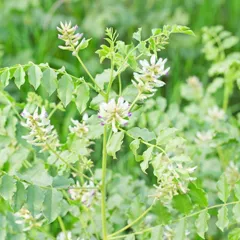
Gan Cao is an envoy ingredient in Hua Ban Tang. This means that it directs the formula towards certain area of the body and/or harmonizes the actions of other ingredients.
5. Liquorice (Gan Cao)
Part used: Dried root and rhizome
Nature: Neutral
Taste(s): Sweet
Meridian affinity: HeartLungSpleenStomach
Category: Tonic herbs for Qi Deficiency
In general Gan Cao's main actions are as follows: "Tonifies the Basal Qi and nourishes the Spleen Qi. Clears Heat and dispels toxicity. Moistens the Lungsexpel phlegm and stop coughing. Relieves spasms and alleviates pain. Harmonizes and moderates the effects of other herbs."
In the context of Hua Ban Tang, it is used because it supplies the Middle Burner Qi and harmonizes the actions of the other ingredients.
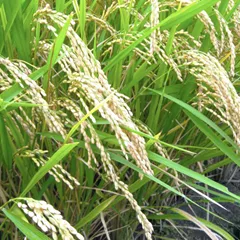
Jing Mi is an envoy ingredient in Hua Ban Tang. This means that it directs the formula towards certain area of the body and/or harmonizes the actions of other ingredients.
6. Rice Sprouts (Jing Mi)
Part used: Seed kernels
Nature: Neutral
Taste(s): Sweet
Meridian affinity: SpleenStomach
Category: Tonic herbs for Qi Deficiency
In general Jing Mi's main actions are as follows: "Replenishes Qi and tonifies the Spleen and Stomach. Eliminates thirst. Stops diarrhea."
In the context of Hua Ban Tang, it is used because it supplies the Middle Burner Qi and harmonizes the actions of the other ingredients.
Conditions and patterns for which Hua Ban Tang may be prescribed
It's important to remember that herbal formulas are meant to treat patterns, not "diseases" as understood in Western Medicine. According to Chinese Medicine patterns, which are disruptions to the body as a system, are the underlying root cause for diseases and conditions.
As such Hua Ban Tang is used by TCM practitioners to treat two different patterns which we describe below.
But before we delve into these patterns it is worth mentioning that they're often associated with the condition "macular rash". Again it wouldn't be correct to say "Hua Ban Tang treats macular rash". Rather, Hua Ban Tang is used to treat patterns that are sometimes the root cause behind macular rash.
Now let's look at the two patterns commonly treated with Hua Ban Tang.
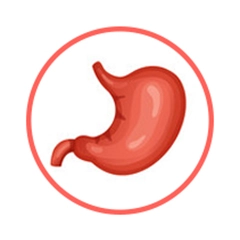
The Stomach is a so-called "Fu" Organ. Learn more about the Stomach in Chinese Medicine
Stomach Heat or Fire
Pulse type(s): Rapid (Shu), Slippery (Hua), Full (Shi)
Tongue coating: Yellow coating
Tongue color: Red centre
Symptoms: Acne Nausea Dry mouth Dry stools Bad breath Mouth ulcers Constipation Irritability Painful gums Restlnessness Bleeding gums Swelling gums Intense thirst Feeling of heat Constant hunger Excessive hunger Frontal headache Sour regurgitation Desire for cold drinks Burning epigastric pain Vomiting of fluids soon after drinking
Hua Ban Tang is sometimes prescribed by TCM practitioners to treat Stomach Heat or Fire. This pattern leads to symptoms such as burning epigastric pain, intense thirst, desire for cold drinks and restlnessness. Patients with Stomach Heat or Fire typically exhibit rapid (Shu), slippery (Hua) or full (Shi) pulses as well as Red in the center with a dry thick yellow or dark yellow coating.
Stomach Fire indicates a true Excess of Heat in the Stomach, creating symptoms such as mouth ulcers, bad breath, intense thirst as well as strong desire for cold drinks and foods. The Blood in the Stomach Channel get rebellious due to the extreme Heat or Fire, so that it leaks out of vessels and... read more about Stomach Heat or Fire
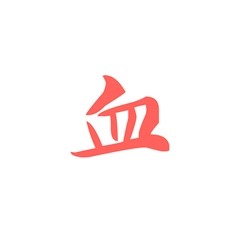
Blood (Xue) is one of Chinese Medicine's vital subtances. Learn more about Blood in Chinese Medicine
Heat in the Blood
Pulse type(s): Rapid (Shu)
Tongue color: Red
Symptoms: Fever Thirst Eczema Anxiety Itching Insomnia Delirium Red face Tinnitus Dry mouth Dizziness Dark Urine Dry stools Dry throat Bloody nose Malar flush Bloody urine Irritability Restlessness Night sweats Constipation Bloody sputum Bloody stools Heavy periods Restlnessness Early periods Cough of blood Abdominal pain Scanty periods Feeling of heat Delirious speech Vomiting of blood Red skin eruptions Dark colored blood Pale color periods Thick menstrual blood Black and tarry stools Thin and watery periods Bitter taste in the mouth Frequent bleeding episodes Trickling blood after period Dark clots in menstrual blood Pre-menstrual breast distention Abdominal distention and fullness Flooding suddenly before schedule Thirst with an inability to swallow Frequent bleeding episodes in stools urine or vomit
Hua Ban Tang is sometimes prescribed by TCM practitioners to treat Heat in the Blood. This pattern leads to symptoms such as feeling of heat, red skin eruptions, thirst and frequent bleeding episodes. Patients with Heat in the Blood typically exhibit rapid (Shu) pulses as well as Red tongue.
The most common cause of Heat in the Blood is a Heat Pernicious Influence that has invaded the body and agitates the Blood. This results in accelerated blood flow which manifests itself in a rapid pulse, expanded and damaged Blood vessels and often heavy bleeding. The Blood will be fresh red or... read more about Heat in the Blood
Formulas similar to Hua Ban Tang
Bai Hu Tang is 67% similar to Hua Ban Tang
Zhu Ye Shi Gao Tang is 43% similar to Hua Ban Tang
Qing Wen Bai Du Yin is 36% similar to Hua Ban Tang
Mai Men Dong Tang is 33% similar to Hua Ban Tang
Yu Nu Jian is 33% similar to Hua Ban Tang
Ma Xing Shi Gan Tang is 33% similar to Hua Ban Tang

